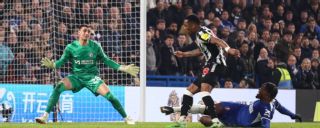|
The only thing worse than playing in an underachiever derby is losing an underachiever derby. On Monday evening in West London, Chelsea, distributor of €1.1 billion in transfer fees over the last two years and owner of the fourth-largest estimated payroll in the Premier League (per Capology), thumped Newcastle, by some definitions the richest club in the richest league in the world, by a 3-1 margin. The win didn't really do anything for Chelsea -- they're still 11th in the table, eight points behind sixth-place Manchester United (a fellow underachiever) -- but it at least dragged Newcastle further into the muck. The Magpies, who qualified for the Champions League for the first time in 20 years last season but finished last in their group, are now 10th, only one point ahead of Chelsea. Assuming England's performance in this year's UEFA competitions is good enough to snare a fifth Champions League bid (and, therefore, a seventh spot in a UEFA competition), then barring an FA Cup title Newcastle only has a 38% chance of playing in Europe next season, per Opta's power ratings, while Chelsea's at 31%. These two clubs will land on any 2023-24 underachiever list. But what explains their problems? And who joins them on said list? Below are seven teams that fit the label in one of two ways. Three (Chelsea, Manchester United, Sevilla) are here because their estimated wages are far too high for their position in the table to be so low. Four others (Napoli, Newcastle, Lazio, Union Berlin) are here because their current pace is far lower than what qualified them for this season's Champions League. Let's look at the stats behind some of this year's more disappointing teams.
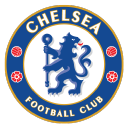 Chelsea, English Premier League Chelsea, English Premier League
League status: 11th place, 39 points from 27 games What the stats say: If you don't tilt the field, you don't win the game
If you squint just right, you can see some hope at Stamford Bridge. Chelsea have taken 17 points from their last nine league matches, and while they lost to what was basically Liverpool's C-team in the League Cup final, they still made the League Cup final. They're into the FA Cup quarterfinals as well. In other words, it could be worse -- it could be last season, for example, when Chelsea finished 12th in the Premier League, bowed out in the third round of both domestic cup competitions and got blasted out of the Champions League by Real Madrid in the quarterfinals. Chelsea's xG differential in 2023-24 (+9.7) is fifth in the league, which suggests that they've been a bit unfortunate to produce only a +2 goal differential. Finishing has certainly been an issue for the Blues at times -- Nico Jackson has attempted 53 shots worth a team-best 12.6 xG but has scored just nine goals from them, while midfielders Enzo Fernandez and Conor Gallagher have scored five goals from shots worth 8.1 -- and goalkeepers Robert Sanchez and Djordje Petrovic have each allowed more goals than the xG for opponents' shots on target suggest they should have. At the same time, however, this nine-game hot streak they're on has been fortunate by the same measures: They've produced the sixth-best point total in the league from the ninth-best xGD. I'll use an American football term to describe Chelsea's biggest issue this season: field position. Opponents' possessions actually start higher up the pitch (36.2 meters from goal, 14th) than Chelsea's do (35.0, 11th). The best teams tilt the field in their favor. Chelsea do not. 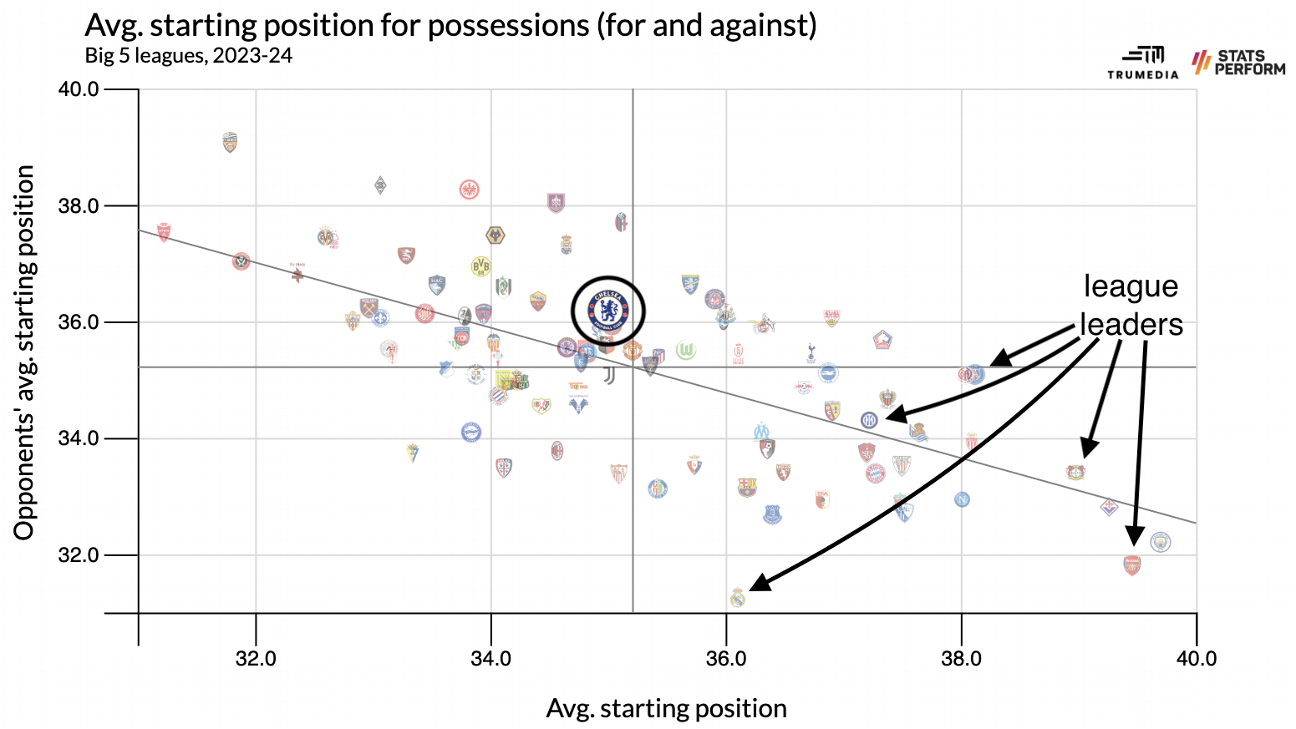 (Source: TruMedia)
(Source: TruMedia)
Coach Mauricio Pochettino is known for wanting to press, and Chelsea's okay at it this season: They're ninth in goals scored from high turnovers, sixth in possessions starting in the attacking third and fifth in passes allowed per defensive action (PPDA, a common measure of defensive intensity). Unfortunately, opponents are just as good at pressuring them: They're 15th in opponents' possessions starting in the attacking third and tied for 12th in goals allowed from high turnovers. Chelsea's overall passing numbers are solid, but their breakdowns have been particularly costly. Considering they've both (a) started 24 different players at least once in league play, and (b) more than half of those starters are 23 or younger, maybe this is to be expected. But if Chelsea are to actually grow into themselves in future seasons, they must improve drastically in the field position battle.
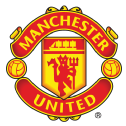 Manchester United, English Premier League Manchester United, English Premier League
League status: 6th place, 47 points from 28 games What the stats say: A fundamental failure to defend
Generally speaking, wages correlate pretty well with success. That makes perfect sense: The best players tend to be the most expensive. (And if they aren't the most expensive, they probably will be pretty soon.) Again using the salary estimates at Capology, six of the seven teams with the highest wage bills in Europe -- PSG (first), Real Madrid (second), Bayern Munich (third), Manchester City (fifth), Barcelona (sixth) and Arsenal (seventh) have advanced to the Champions League quarterfinals. The only big spenders that haven't joined that party? Manchester United. The Red Devils have the fourth-largest estimated wages (€240.8 million per year), and in 2023-24 that cash has bought them a last-place finish in their Champions League group and, currently, a sixth-place spot in the Premier League. United's attacking numbers have been poor this year -- they're currently 13th in goals scored, though a lot of that comes down to a sustained finishing funk for the trio of Bruno Fernandes, Casemiro and Antony (combined: five goals from shots worth 11.1 xG). They're tied for eighth in shots per possession and ninth in xG per shot, which isn't good enough overall but should generally produce at least mid-table scoring. When things go truly awry, however, it's because of a shockingly passive defense. Manchester United have lost 16 games in all competitions this season. In those 16 matches, they've allowed 40 goals - at least two goals in 13 and at least three in nine. (They also allowed three goals in a Champions League draw with Galatasaray and three in a win over Wolves.) Goalkeeper Andre Onana has made a few crippling mistakes this season, but comparing his goals allowed to opponents' post-shot xG for shots on target, he's allowed 5.1 fewer goals than expected in Premier League play. He's been at an incredible +1.4 goals prevented or higher in four matches, including one-goal wins over Copenhagen and Aston Villa and a scoreless draw with Liverpool. When Onana is good, he's great, and he's a big reason why United are averaging a rather fortunate 2.1 points per game in matches decided by 0-1 goals. The defense is just giving him so much work to do. While United don't allow a ton of high-quality shots -- they're third in the league in xG allowed per shot -- the quantity of shots they allow is overpowering at times. Only seventh-place West Ham, 18th-place Luton Town and last-place Sheffield United allow more shots per possession: 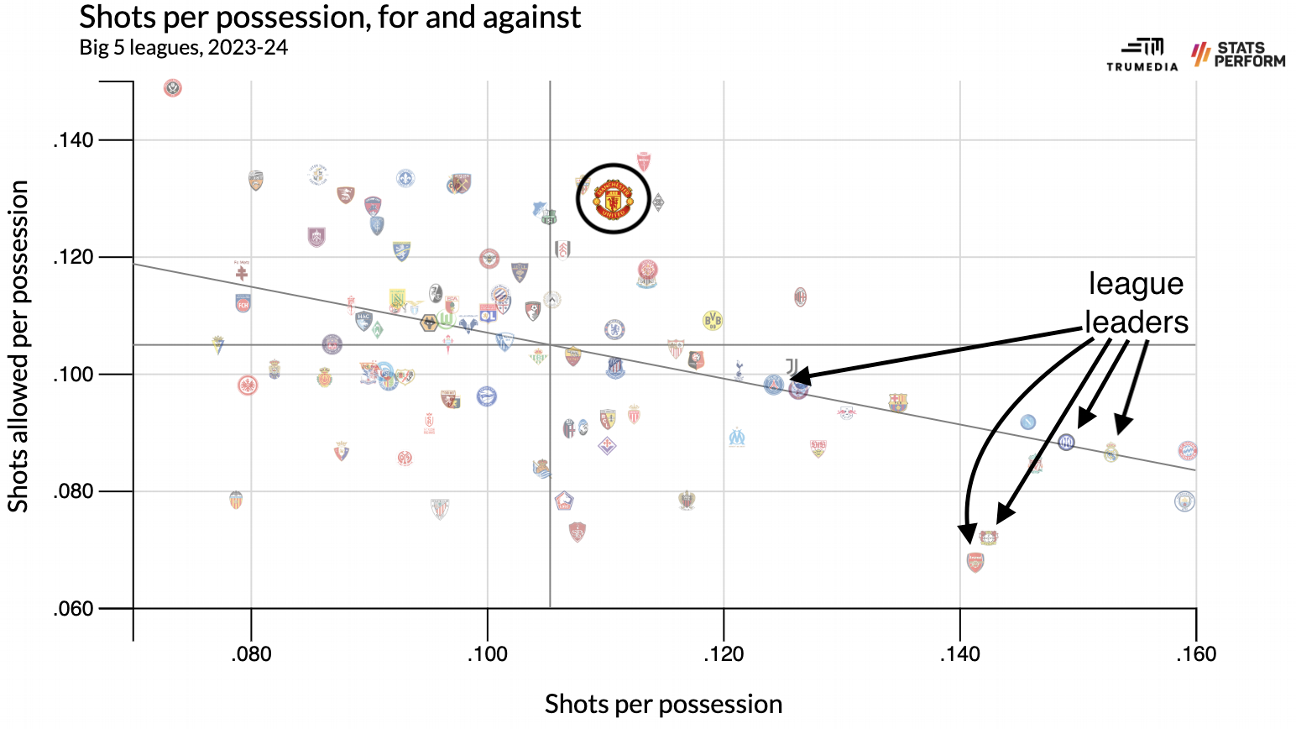 (Source: TruMedia)
(Source: TruMedia)
As with Chelsea, United have been undone by occasional self-destruction. Opponents are creating 37.0 high turnovers per match in open play (only Sheffield United and Nottingham Forest commit more) and starting 9.6% of their possessions in the attacking third (fifth-most). United are therefore generating fewer touches in both the attacking third and the box than they allow. They're getting outscored in both counter-attacks and set pieces, too. Sixth place is dreadful considering how much they're spending, but you can make a pretty good case that sixth place is also a little bit lucky.
 Napoli, Italian Serie A Napoli, Italian Serie A
League status: 7th place, 44 points from 28 games What the stats say: Blame a decline in shot quality and finishing
Napoli are the anti-United in 2023-24: They're doing just fine in the shot quantity department -- in terms of both shots attempted and allowed, they're basically dead even with Serie A leader Inter -- but they're dreadfully mediocre in terms of shot quality:  (Source: TruMedia)
(Source: TruMedia)
Last season, Napoli lapped the Serie A field by drowning opponents in both elite shot quantity, above-average shot quality and elite finishing. Victor Osimhen and Khvicha Kvaratskhelia combined for 38 league goals (more than half of Napoli's total) and 14 assists, and Napoli both averaged a solid 0.15 xG per shot overall (0.13 from the scoring duo) and finished at a particularly high level: They scored 75 goals from shots worth 66.0 xG. This season has been a grind. Osimhen missed a month and a half with a hamstring injury and has played in only 17 of 28 games; that has tamped down the raw output of the Osimhen-Kvaradona duo (to date: 21 goals, seven assists). Beyond that, though, shot quality is not where it needs to be, as you can see above, and Napoli's finishing has regressed significantly. While Osimhen and Kvaratskhelia have continued to finish well, as a team they've scored just 42 goals from shots worth 47.2 xG; in defense, meanwhile, they've slipped from third in xG allowed per shot to 10th, and opponents have gone from underachieving their xG figures by 4.1 goals in 2022-23 to overachieving them by 9.8. Whatever good fortune Napoli enjoyed while winning their first Scudetto in 33 years last season has reversed fully because eventually, xG comes for us all. But even when Osimhen has been healthy, they also just haven't put themselves in as many favorable scoring possessions. Only 65% of their shots have come from inside the box (down from 69% last season), which has contributed to the fact that they have put only 32% of their shots on goal (down from 36%). They may dominate shot quantity like Inter, but they merely break even in terms of shot quality. Sprinkle in some poor fortune, and you're in seventh place and on your third manager of the season. Of course, it could be worse. Napoli has been average from a shot quality perspective: Sevilla has been an abject disaster.
 Sevilla, Spanish Primera Division Sevilla, Spanish Primera Division
League status: 14th place, 28 points from 28 games What the stats say: They're really bad, but teams below them are much worse
Sevilla's on this list because their estimated wages are almost as high as anyone in LaLiga not named Real Madrid or Barcelona, but truthfully they've been a mess for a while now. They cranked through three managers in 2022-23 and found themselves in the relegation zone as late as March 11 before rallying to finish 12th. Meanwhile, a burst of great home results charged yet another run to the Europa League final, where they upset Roma in penalties. That earned them a spot in the Champions League despite a losing record in league play. The only reason they aren't again heavily involved in a relegation fight in early March is that the bottom of LaLiga is horrendous this season. They have only 28 points with six wins from 28 matches, but that's still good enough to keep them six points clear of the drop zone at the moment. Injuries have absolutely wrecked any hope for progress -- they've started 29 different players at least once in league play. Only forward Lucas Ocampos has started more than 19 matches, and 14 different players by my count have missed at least five matches due to injury -- and because of this, their summer signings have barely helped at all. In defense, they permanently added Nottingham Forest's Loic Bade for €12 million and an estimated salary of €3.3m per year, per Capology; they also signed PSG's Sergio Ramos for €2.2m per year. Bade and Ramos have started 19 and 18 matches, respectively, but they're among six different center-backs to have started at least once because of injuries and shuffling. In attack, Sevilla added Hertha Berlin's Dodi Lukebakio for €10m and an estimated €3m per year salary; they also drew veteran Mariano Diaz from Real Madrid for an estimated €5.2m per year, second-highest wage on the team. They have combined for just 11 starts and 979 total minutes, and Lukebakio's goal against Almeria on Monday was just his third of the season. That's three more than Diaz has scored. An incongruous and inconsistent lineup has produced predictably inconsistent results. Sevilla have created nearly the fewest high-quality chances in the Big 5 leagues (which we'll define as shots worth 0.2 xG or more) and have allowed nearly the most. 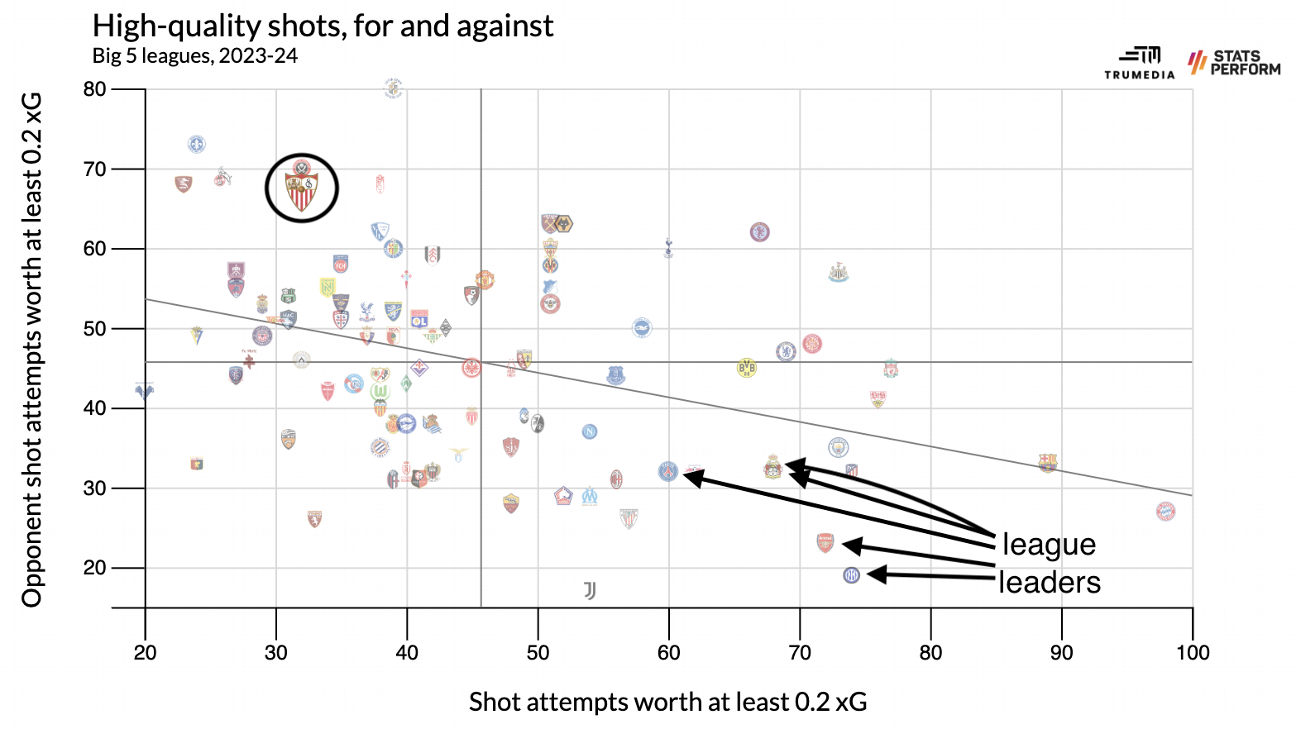 (Source: TruMedia)
(Source: TruMedia)
For all the poor fortune they've seen in the injuries department, however, they at least benefit from the poor teams around them. Sevilla is on pace for just 38 points in 38 matches, a total that would have gotten a team relegated in 2021-22 and 2022-23. But they're safe ... for now.
 Newcastle United, English Premier League Newcastle United, English Premier League
League status: 10th place, 40 points from 28 games What the stats say: Wobbly defending means they fall behind ... and then stay behind
Sevilla's injuries have been so dramatic that it almost makes Newcastle's situation look stable. Why, they've only started 24 different players and, by my count, lost 12 players to injury for at least five games! That's nothing! It's quite a bit if you are trying to back up last year's top-four finish, however. And with the way that injuries (and other issues) have struck the defense specifically -- goalkeeper Nick Pope has started only 14 league matches, center back Sven Botman has started 15 and high-priced new defensive midfielder Sandro Tonali has started only five due to an 18-month gambling suspension -- the Magpies have experienced a total collapse on that side of the ball. Newcastle have been poor in every way a defense can be poor in 2023-24. They rank 13th in shots allowed per possession and 17th in xG allowed per shot. They've also allowed 71 shot attempts with fewer than two defenders between the shot and the goal; that's also 17th. As with Chelsea and Manchester United, their buildup play has been somewhere between mediocre and poor. They rank ninth in high turnovers committed from open play, 13th in opponents' possessions starting in the attacking third and 18th in opponents' ball recoveries in the attacking third. And when they have to open up the game from a losing position, disaster strikes.  (Source: TruMedia)
(Source: TruMedia)
Want to know how you can drop pretty far in the table in a short amount of time? Go from trailing on only 13% of possessions (second in the Premier League) and averaging 1.1 points per game from trailing positions (third) to trailing on 24% of possessions (seventh) and averaging a ghastly 0.2 points per game from a trailing position (18th). They've trailed in 15 matches this season and have managed just three draws and 12 losses; on Monday against Chelsea, they fell behind in just the sixth minute, and even after drawing even right before halftime, they allowed a pair of goals in the second half and lost 3-2. Newcastle's defense has been wobbly all season, and if the game state requires them to commit any extra resources into the attack, opponents counter-attack them with vigor: They're 18th in counter-attacking goals allowed. And it could very well cost them a spot in a European competition next season.
 Lazio, Italian Serie A Lazio, Italian Serie A
League status: 9th place, 40 points from 28 games What the stats say: Regression to the mean, as conceding too many shots is finally hurting them
Regression to the mean is unbeaten and strikes us all down eventually. In 2022-23, Lazio turned pretty good fortune into a great season. They ranked just eighth in Serie A in xG differential and attempted fewer shots than their opponents for the season; somehow, they still managed to finish second in the league. They won games with absurdly passive defense because (a) Ivan Provedel was probably the best goalkeeper in the league (he had a 76% save percentage and allowed 3.6 fewer goals than post-shot xG figures suggested he should), and (b) the veteran trio of Mattia Zaccagni, Sergej Milinkovic-Savic and Felipe Anderson all dramatically overachieved in attack, turning shots worth 19.5 xG into 28 goals. This year, Milinkovic-Savic is in the Saudi Arabian league, while Zaccagni, Anderson and Provedel are all mortal again. Zaccagni and Anderson have scored six goals from shots worth 6.1 xG, and Provedel has allowed 2.1 more goals than post-shot xG suggests he should have. In terms of xG differential, Lazio have fallen from eighth to 10th, but since they're no longer overachieving, they're now also ninth in points and goal differential. Even when you have Ciro Immobile up front, it's ridiculously difficult to play at a top-four level when your opponents are attempting more shots than you. In fact, in the last 10 seasons, only eight teams from Big 5 leagues have averaged at least 1.75 points per game with a negative shot margin: Teams averaging at least 1.75 points per game with a negative shot differential, last 10 years: 1. Girona 2023-24 -- 2.21 points per game (PPG) so far 2. Nice 2016-17 -- 2.05 PPG 3. Sevilla 2014-15 -- 2.00 PPG 4. Lazio 2022-23 -- 1.95 PPG 5. Borussia Monchengladbach 2014-15 -- 1.94 PPG 6. Arsenal 2018-19 -- 1.84 PPG 7. Eintracht Frankfurt 2020-21 -- 1.76 PPG 8. Villarreal 2016-17 -- 1.76 PPG
Of the teams on that list that aren't last year's Lazio or this year's Girona, all six saw their points-per-game averages fall the next season, and by an average of 0.44 points. Lazio's has currently fallen by 0.47, almost perfectly in line with those averages. (This also probably tells us something about what might happen to Girona next season, but we'll worry about that later.)
 Union Berlin, German Bundesliga Union Berlin, German Bundesliga
League status: 14th place, 25 goals from 25 games What the stats say: Shot quality and quantity has gone down, and so have their results
It appears that not even the magic of the Stadion An der Alten Forsterei -- the most magical place on earth, in this writer's humble opinion -- can allow you to defy the xG gods forever. Over the three seasons between 2020-21 and 2022-23 -- during which they enjoyed their highest ever Bundesliga finish (sixth), then topped it (fifth), then topped it again (fourth, with a Champions League bid) -- Union Berlin created a total xG differential of just +8.4 but turned that into a goal differential of +26. They were as good as anyone in keeping defenders behind the ball and cluttering shooting lanes, and they appeared particularly adept at turning familiar patterns of attack into consistent and successful shots. They defied math long enough that you could almost convince yourself they would do it forever. No one defies math forever. This year's xG differential: -8.0. This year's goal differential: -18. But it's even worse than that. In all competitions, they've generated a positive xG differential in just 10 games (not great), but they've also only managed to win five of those 10 matches with one draw and four losses. They've gotten worse, and their luck has gotten much worse. The defense has regressed, but the big problem is that Union is no longer turning mediocre shots into good opportunities. 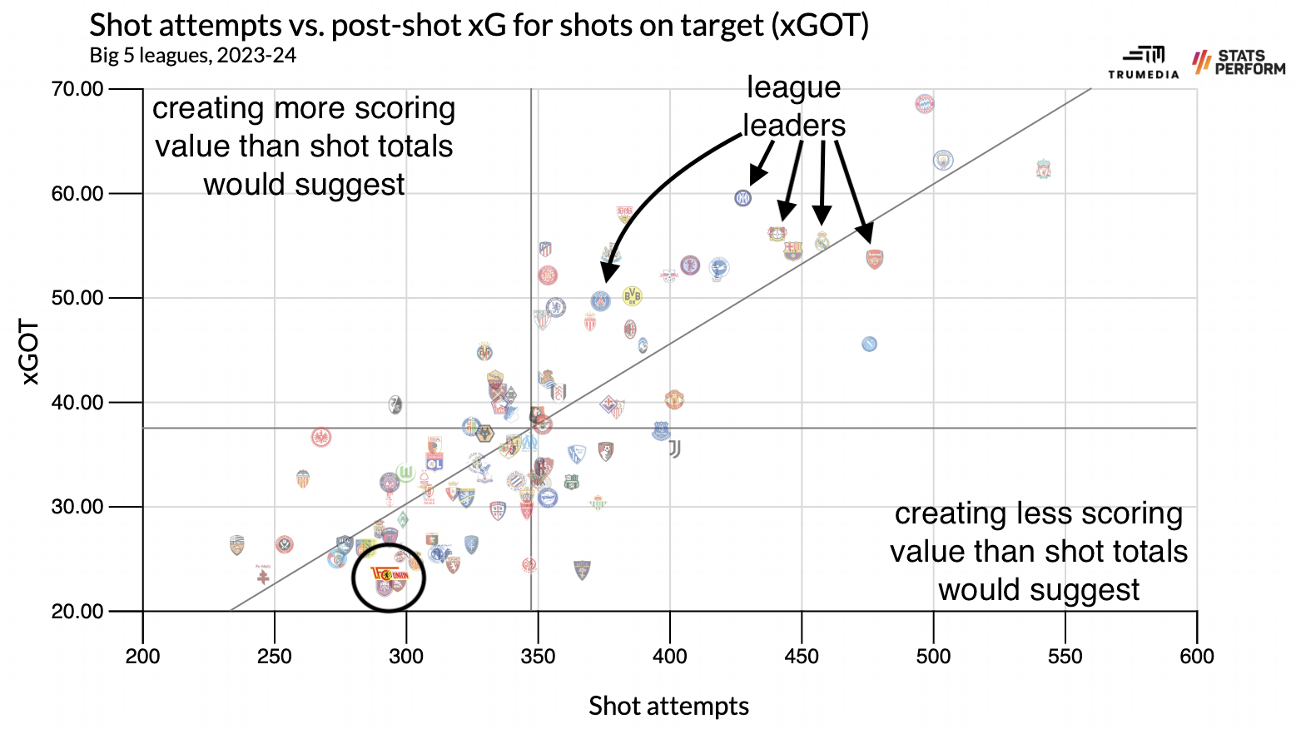 (Source: TruMedia)
(Source: TruMedia)
Union was never a high-possession, high-shot quantity team, but they made up for it by placing the shots they got really well. Now they're near the league bottom of the Big 5 in terms of both shot attempts and shot quality. This was always going to be a strange year for Eisern Union. The club didn't want to over-extend itself just because of securing a Champions League berth and therefore tried to bring in affordable veterans like forward Kevin Volland, wingback Robin Gosens and defender Leonardo Bonucci, along with loanees like attackers David Datro Fofana and Brenden Aaronson and midfielder Alex Kral. It didn't work -- Union finished last in its Champions League group and, at one point, went winless in 16 consecutive matches -- and Bonucci, Fofana and veteran forwards Sheraldo Becker and Kevin Behrens are already gone. They're probably not in a relegation scrap anymore; thanks to improved play early in 2024, they're seven points above the relegation zone with nine matches remaining. But both reality and gravity have returned to Kopenick.
|

